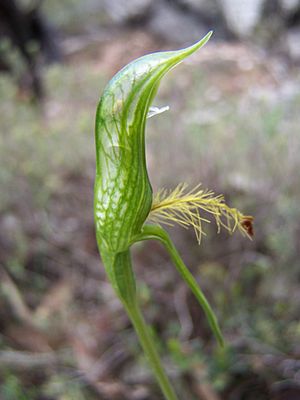Bearded greenhood facts for kids
Quick facts for kids Bearded greenhood |
|
|---|---|
 |
|
| Scientific classification | |
| Genus: |
Pterostylis
|
| Species: |
plumosa
|
| Synonyms | |
|
|
The Pterostylis plumosa, also called the bearded greenhood or plumed greenhood, is a type of orchid. It belongs to the Orchidaceae family. This special flower grows only in south-eastern Australia and maybe New Zealand. It gets its "bearded" name from its long, thin "lip" (called a labellum). This lip has golden hairs around its edges.
What Does the Bearded Greenhood Look Like?
The Pterostylis plumosa is a perennial herb. This means it's a plant that lives for more than two years. It grows from round underground tubers. These plants often form small groups.
They can grow to be about 12–20 centimetres (5–8 in) tall. Each plant has 5 to 20 soft, pale green leaves. These leaves are shaped like a spearhead. They grow close together at the bottom of the stem and reach upwards. The leaves are about 10–30 millimetres (0.4–1 in) long and 5–15 millimetres (0.2–0.6 in) wide.
Each plant usually has one flower. The flower is about 30 millimetres (1 in) long. It stands upright and looks a bit see-through. It has thin, dark green lines all over it. The special "lip" (labellum) is long and thin, about 1.5 millimetres (0.06 in) wide. It has golden-yellow hairs, making it look "bearded." The tip of the lip is a red-brown knob. The back part of the flower, called the dorsal sepal, narrows to a thin point about 4 millimetres (0.2 in) long. These beautiful flowers bloom from August to November.
How It Got Its Name
The Pterostylis plumosa was first officially described in 1969. A scientist named Leo Cady wrote about it in a magazine called "Australian Plants." He found a sample of the plant near Abercrombie Caves.
The second part of its scientific name, plumosus, is a Latin word. It means "feathered." This name perfectly describes the golden, feathery hairs on the orchid's lip.
Where Does It Grow?
The bearded greenhood is found in several parts of Australia. You can see it in New South Wales, Victoria, South Australia, and Tasmania. Scientists also think it might grow in New Zealand.
It's not a very common plant. It prefers to grow in areas with "heathy woodland." This means it likes places with small shrubs and some shade.

